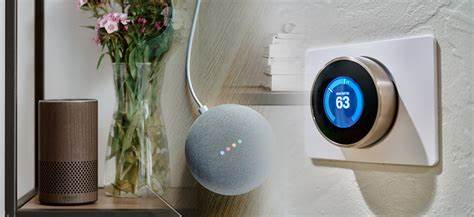
The Rise of Smart Homes in India
India’s smart home market has experienced exponential growth due to a number of factors, including the spread of internet connectivity, technological advancements, and rising energy efficiency awareness. A Statista report projects that the smart home market in India will generate revenue at a compound annual growth rate (CAGR) of 22.6% from 2021 to 2025, with a projected market volume of USD 6.11 billion. This increase is evidence of Indian consumers’ growing acceptance and desire for smart home solutions.
Key Components of Smart Homes
Smart homes are equipped with a variety of interconnected devices and systems that can be controlled remotely, offering enhanced convenience, security, and efficiency. Some of the key components include:
- Smart Lighting Systems: These systems allow users to control lighting remotely using smartphones or voice commands. They can be programmed to adjust brightness and color based on the time of day or specific activities, contributing to energy savings and creating the desired ambiance.
- Smart Security Solutions: Enhanced security is a significant aspect of smart homes. This includes smart locks, video doorbells, surveillance cameras, and motion sensors that can be monitored and controlled remotely, providing homeowners with peace of mind.
- Smart Thermostats: These devices enable efficient temperature control by learning user preferences and adjusting settings accordingly. They contribute to energy savings and ensure optimal comfort throughout the day.
- Voice-Activated Assistants: Devices like Amazon Echo and Google Home have become integral to smart homes, allowing users to control various smart devices, access information, and perform tasks using voice commands.
- Smart Appliances: From refrigerators to washing machines, smart appliances are becoming increasingly common. They offer features like remote monitoring, automatic adjustments, and integration with other smart home systems.
Impact on Interior Design
The advent of smart home technology has had a profound impact on interior design, necessitating a shift in how spaces are planned, designed, and utilized. Some of the significant impacts include:
1. Integration of Technology with Aesthetics
Interior designers now need to seamlessly integrate technology with aesthetics. Smart devices and systems should not only function efficiently but also blend harmoniously with the overall design. This requires innovative design solutions that incorporate hidden wiring, discreetly placed sensors, and aesthetically pleasing control panels.
2. Enhanced Customization
Smart homes offer unparalleled customization options. Lighting, temperature, and even the ambiance can be adjusted to suit individual preferences. Interior designers can leverage this flexibility to create personalized living spaces that cater to the unique needs and preferences of homeowners.
3. Space Optimization
With the increasing trend of urbanization and shrinking living spaces, smart home technology plays a crucial role in space optimization. Multi-functional furniture, automated storage solutions, and integrated appliances help maximize the use of available space, making homes more efficient and comfortable.
4. Focus on Sustainability
Sustainability is a key consideration in modern interior design. Smart home technology contributes to sustainability by improving energy efficiency and reducing waste. For instance, smart lighting systems and thermostats help minimize energy consumption, while smart appliances are designed to operate more efficiently.
5. Enhanced Safety and Security
The integration of smart security solutions has raised the bar for home safety. Interior designers need to consider the placement and integration of security devices like cameras and sensors to ensure comprehensive coverage without compromising on aesthetics.
Challenges and Considerations
While the adoption of smart home technology offers numerous benefits, it also presents certain challenges that need to be addressed:
- Cost: The initial cost of setting up a smart home can be significant. However, the long-term benefits in terms of energy savings and enhanced convenience often justify the investment.
- Compatibility and Interoperability: With numerous smart devices available in the market, ensuring compatibility and seamless integration can be challenging. Homeowners and designers need to choose systems that are compatible with each other to avoid potential issues.
- Privacy and Security: The increased connectivity in smart homes raises concerns about data privacy and security. It is essential to implement robust security measures to protect against potential cyber threats.
- User Training and Adaptation: Transitioning to a smart home requires a certain level of technological proficiency. Homeowners need to be educated on how to use and maintain their smart devices effectively.
Future Prospects
The future of smart homes in India looks promising, with continuous advancements in technology and increasing consumer awareness. Some of the trends that are likely to shape the future include:
- Artificial Intelligence (AI) and Machine Learning (ML): AI and ML are set to play a significant role in smart homes, enabling devices to learn user preferences and optimize performance. This will lead to more intuitive and efficient home automation systems.
- Internet of Things (IoT) Integration: The integration of IoT is expected to expand, connecting an even broader range of devices and systems. This will enhance the overall functionality and convenience of smart homes.
- Energy Management Systems: Advanced energy management systems will become more prevalent, allowing homeowners to monitor and control energy usage more effectively. This will contribute to greater sustainability and cost savings.
- Health and Wellness Features: Smart homes will increasingly incorporate features that promote health and wellness, such as air quality monitors, smart fitness equipment, and wellness-focused lighting systems.
- Voice and Gesture Control: The development of more sophisticated voice and gesture control systems will make interacting with smart home devices even more seamless and intuitive.
Conclusion
With their unparalleled levels of convenience, customization, and sustainability, smart homes are redefining the interior design landscape in India. As technology advances and changes the way we use our living spaces, smart homes will become an essential part of modern living. To create beautiful, smart, and future-ready homes, interior designers and homeowners alike must embrace this technological revolution.
India’s journey towards smart homes is just getting started, and there are countless opportunities. The dream of a fully connected and intelligent home is achievable with the correct strategy and creative solutions, offering a better, more effective, and pleasurable living environment for everybody.